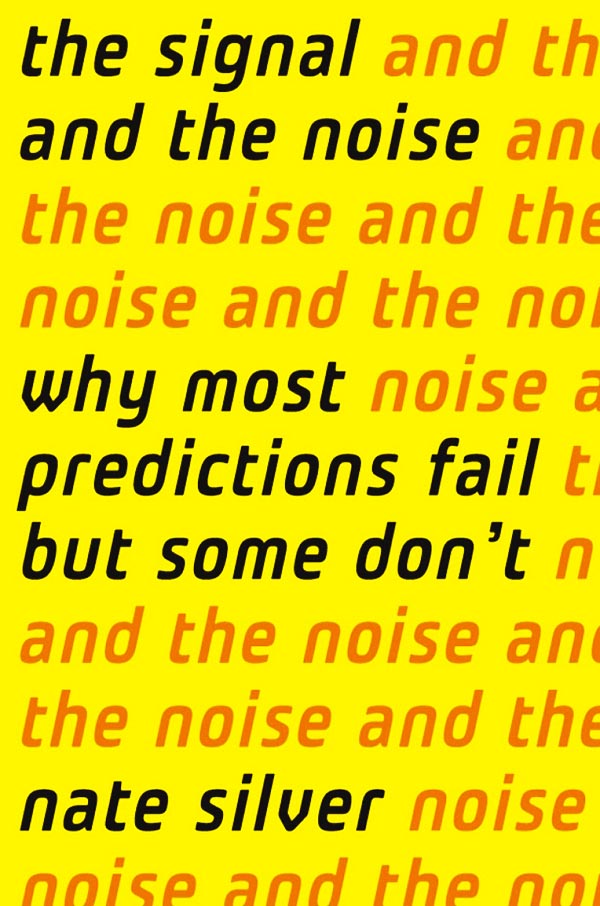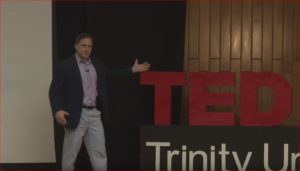I took a mandatory course in high school[1] called “Theory of Knowledge,” meant to help us consider ‘How do we know things?”
“How do we know things?” turns out to be one of those big philosophical questions – dating from the time of Plato & Aristotle – irritating all of us for the last few millenia.
What Nate Silver addresses more than anything in The Signal and The Noise: Why So Many Prediction Fail – But Some Don’t is how we know things – in particular how we use and misuse information to understand and make predictions about complex phenomena such as baseball performance, political outcomes, the weather, earthquakes, terrorist attacks, chess, Texas Hold ‘em poker, climate change, the spread of infectious diseases, and financial markets.
I’ve written before that it’s Nate Silver’s world, and we just live in it.[2] The Signal and The Noise offers a 21st Century answer to the question of ‘how do we know things?’ Because most of us, and most media, do not yet think this way, Silver implicitly criticizes everything I hate about the Financial Infotainment Industrial Complex.
Big Ideas vs. Small Ideas
Silver argues effectively that we frequently go wrong in many areas when we adopt a single model or approach to a problem, when an evolving, flexible, multiple-input, probabilistic approach would serve us better.
The problem of political pundits
Silver repeatedly returns in The Signal and the Noise to criticize political pundits on a TV show called The McLaughlin Group, on which commentators from the left and the right appear to make bold political predictions. Silver – among the most widely admired public forecasters of political outcomes – eviscerates this type of ‘prediction,’ citing data that shows these commentators make accurate predictions no more often than would a random coin toss.
But television rewards ‘bold stances’ and ‘big ideas’ of the type The McLaughlin Group traffics in, while largely ignoring more thoughtful approaches.
Silver labels and criticizes the “Big Idea” mindset that passes for political commentary on television in favor of a more modest, probabilistic, and empirical “Small Idea” mindset. Small ideas, nuanced, uncertain, and modest, however, make for poor television ratings.
But Silver does have a Big Idea himself
For complex, hard to predict phenomena[3], Silver explains his preferred method, based on a probability theorem attributed to an 18th Century English minister Thomas Bayes.
No doubt Silver thinks many more of us should become familiar with this branch of probability and statistics math. [4]
Beyond the Bayesian theory, however, Silver encourages us to adopt a probabilistic world-view. His big idea is for us to move away from “I have the explanation and I know what’s going to happen,” to a different way of understanding the world characterized by “I can articulate a range of outcomes and attach meaningful probabilities to the possible outcomes.”
Over time, as we refine our data gathering and multifaceted models, we can move our small ideas forward and become ‘less wrong’ about the world.
In the investment world the former style of traders – the one’s with big ideas and certainty – may have a good run of success, but generally get flushed out when markets turn. The best traders I’ve ever worked with think and speak in the latter way, considering new possibilities as markets evolve.
Some parts of this remind me of Nassim Taleb
The habits of mind Silver’s book encourages are not dissimilar to Nassim Taleb’s empirical skepticism, although they differ greatly in style and in points of emphasis. Taleb tends to be aggressively critical of everybody else’s models, whereas Silver more generously praises other theorists’ models and critiques his own.
Both Taleb and Silver share, however, a restless dissatisfaction with the inputs into our understanding right now. Both would say we do not know enough. We have not considered enough factors to explain whatever phenomenon we purport to explain. Our models need improvement and perpetual skepticism. The best we can do is to think probabilistically about future events.
Both encourage a learned humility about what we can know or patterns we think we observe in the world.
How does this relate to investing?
I’d estimate only about ten percent of Silver’s book explicitly addresses investing. As I mentioned, The Signal And The Noise is really a “Theory of Knowledge” book rather than in investing book.
But because Silver thinks like the best financial traders, uses probabilistic math effectively, and writes more clearly than almost anyone, his ideas are worth applying to investing.
1. Attribution of success
Among people who invest their own or other people’s money, 99.5%[5] of us attribute successful outcomes to personal investing acumen, while attributing unsuccessful outcomes to circumstances beyond our control.
The noise surrounding our own success – misinterpreting a generally rising market as stock-picking skill for example – leads us to overestimate our ability to influence investment returns. As a result, too many of us engage in security selection, or too many of us pay others to achieve superior investment results, despite the evidence that we’re overpaying.
2. Responsibility for failure
Conversely, our abdication of personal responsibility for losses – it must have been ‘the bad markets’ after all! – leads us to underestimate our own errors of judgment.
In both cases – success or failure – we’re prone to adopt an uncritical approach to the right level of responsibility for outcomes.
3. Efficient market hypothesis as an illustration of the Bayesian approach
Although Silver gives numerous examples of his Bayesian probabilistic approach to problems with numbers, one of his best examples is purely textual, on the efficient market hypothesis. He lists seven increasingly accurate, yet also qualified and probabilistic statements, on what we know about efficient markets.
The series of increasingly accurate, yet ‘less bold,’ statements are not only a great illustration of his big idea but also the right lesson for us on investing, so I reproduce it in full here:
a) No investor can beat the stock market.[6]
b) No investor can beat the stock market over the long run.[7]
c) No investor can beat the stock market over the long run relative to his level of risk.[8]
d) No investor can beat the stock market over the long run relative to his level of risk and accounting for transaction costs.[9]
e) No investor can beat the stock market over the long run relative to his level of risk and accounting for his transaction costs, unless he has inside information[10]
f) Few investors can beat the stock market over the long run relative to their level of risk and accounting for their transaction costs, unless they have inside information[11]
g) It is hard to tell how many investors beat the stock market over the long run, because the data is very noisy, but we know that most cannot relative to their level of risk, since trading produces no net excess return but entails transaction costs, so unless you have inside information, you are probably better off investing in an index fund.[12]
The first approximation – the unqualified statement that no investor can beat the stock market – seems to be extremely powerful. By the time we get to the last one, which is full of expressions of uncertainty, we have nothing that would fit on a bumper sticker. But it is also a more complete description of the objective world.
If you want a 21st Century theory of knowledge, teaching you ‘how to think’ about the major world problems of global warming, financial crashes, avian flu, and terrorism, as well as ephemera like poker, chess, sports betting and baseball, start with The Signal and The Noise: Why So Many Prediction Fail – But Some Don’t by Nate Silver.
Please also see related post on Bayesian Probability and the Red Sox.
Please also see related post All Bankers Anonymous Book Reviews in one place!
[1] Readers who study at an International Baccalaureate (IB) high school will be familiar with the “Theory of Knowledge” course. It’s a really great idea for a course, but I have yet to meet anyone who thought the experience of the course lived up to the idea that inspired it.
[2] Also, he might be a witch.
[3] Each chapter separately tackles baseball, political forecasting, weather, earthquakes, economic growth, infectious disease growth, sports betting, chess, poker, climate change, and terrorism – each in their own way posing a challenge of seeing into the future.
[4] The mathematics of Bayesian probability is relatively straightforward so I think I’ll try in a subsequent post to do it justice.
[5] I rounded down to be conservative, because that’s just good science.
[6] The original, powerful, efficient market thesis
[7] Because, clearly, some people sometimes do, for some period of time
[8] You can take some crazy stock-market risks and WAY outperform boring stodgy stocks much of the time. We have to match up comparable investment risk levels.
[9] A theoretical ‘market-beating’ high volume trading strategy often looks less market-beating when you take into account the frictions of trading.
[10] Inside information sure is helpful, when trying to beat the market
[11] Maybe some can do it, like Warren Buffett, but it’s super rare. Probably you can’t do it.
[12] So carefully hedged! So qualified and full of doubts! So true!
Post read (11271) times.






